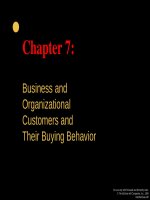Lecture Managerial economics - Chapter 7: Pricing strategies for firms with market power
Bạn đang xem bản rút gọn của tài liệu. Xem và tải ngay bản đầy đủ của tài liệu tại đây (656.16 KB, 44 trang )
Week 7:
Pricing Strategies for Firms
with Market Power
11-2
Overview
I. Basic Pricing Strategies
Monopoly & Monopolistic Competition
Cournot Oligopoly
II. Extracting Consumer Surplus
Price Discrimination
Block Pricing
Two-Part Pricing
Commodity Bundling
III. Pricing for Special Cost and Demand Structures
Peak-Load Pricing
Cross Subsidies
Transfer Pricing
IV. Pricing in Markets with Intense Price Competition
Price Matching
Brand Loyalty
Randomized Pricing
Standard Pricing and Profits for
Firms with Market Power
Price
Profits from standard pricing
= $8
10
8
6
4
MC
2
P = 10 - 2Q
1
2
3
4
5
MR = 10 - 4Q
Quantity
11-3
11-4
An Algebraic Example
• P = 10 - 2Q
• C(Q) = 2Q
• If the firm must charge a single price to all
consumers, the profit-maximizing price is
obtained by setting MR = MC.
• 10 - 4Q = 2, so Q* = 2.
• P* = 10 - 2(2) = 6.
• Profits = (6)(2) - 2(2) = $8.
A Simple Markup Rule
• Suppose the elasticity of demand for the
firm’s product is EF.
• Since MR = P[1 + EF]/ EF.
• Setting MR = MC and simplifying yields
this simple pricing formula:
P = [EF/(1+ EF)] MC.
• The optimal price is a simple markup over
relevant costs!
More elastic the demand, lower markup.
Less elastic the demand, higher markup.
11-5
An Example
•
•
•
•
•
•
Elasticity of demand for Kodak film is -2.
P = [EF/(1+ EF)] MC
P = [-2/(1 - 2)] MC
P = 2 MC
Price is twice marginal cost.
Fifty percent of Kodak’s price is margin
above manufacturing costs.
11-6
Markup Rule for Cournot
Oligopoly
•
•
•
•
Homogeneous product Cournot oligopoly.
N = total number of firms in the industry.
Market elasticity of demand EM .
Elasticity of individual firm’s demand is given
by EF = N x EM.
• Since P = [EF/(1+ EF)] MC,
• Then, P = [NEM/(1+ NEM)] MC.
• The greater the number of firms, the lower the
profit-maximizing markup factor.
11-7
An Example
•
•
•
•
•
•
•
•
Homogeneous product Cournot industry, 3 firms.
MC = $10.
Elasticity of market demand = - ½.
Determine the profit-maximizing price?
EF = N EM = 3 (-1/2) = -1.5.
P = [EF/(1+ EF)] MC.
P = [-1.5/(1- 1.5] $10.
P = 3 $10 = $30.
11-8
11-9
Extracting Consumer Surplus:
Moving From Single Price Markets
• Most models examined to this point involve a
“single” equilibrium price.
• In reality, there are many different prices being
charged in the market.
• Price discrimination is the practice of charging
different prices to consumer for the same good to
achieve higher prices.
• The three basic forms of price discrimination are:
First-degree (or perfect) price discrimination.
Second-degree price discrimination.
Third-degree price discrimiation.
11-10
First-Degree or Perfect
Price Discrimination
• Practice of charging each consumer the maximum
amount he or she will pay for each incremental
unit.
• Permits a firm to extract all surplus from
consumers.
11-11
Perfect Price Discrimination
Price
Profits*:
.5(4-0)(10 - 2)
= $16
10
8
6
4
Total Cost* = $8
2
MC
D
1
* Assuming no fixed costs
2
3
4
5
Quantity
11-12
Caveats:
• In practice, transactions costs and information
constraints make this difficult to implement
perfectly (but car dealers and some professionals
come close).
• Price discrimination won’t work if consumers can
resell the good.
11-13
Second-Degree
Price Discrimination
• The practice of posting a
discrete schedule of
declining prices for
different quantities.
• Eliminates the
information constraint
present in first-degree
price discrimination.
• Example: Electric
utilities
Price
MC
$10
$8
$5
D
2
4
Quantity
11-14
Third-Degree Price Discrimination
• The practice of charging different groups of
consumers different prices for the same product.
• Group must have observable characteristics for
third-degree price discrimination to work.
• Examples include student discounts, senior
citizen’s discounts, regional & international
pricing.
11-15
Implementing Third-Degree
Price Discrimination
• Suppose the total demand for a product is
comprised of two groups with different
elasticities, E1 < E2.
• Notice that group 1 is more price sensitive than
group 2.
• Profit-maximizing prices?
• P1 = [E1/(1+ E1)] MC
• P2 = [E2/(1+ E2)] MC
An Example
• Suppose the elasticity of demand for Kodak film in
the US is EU = -1.5, and the elasticity of demand in
Japan is EJ = -2.5.
• Marginal cost of manufacturing film is $3.
• PU = [EU/(1+ EU)] MC = [-1.5/(1 - 1.5)] $3 = $9
• PJ = [EJ/(1+ EJ)] MC = [-2.5/(1 - 2.5)] $3 = $5
• Kodak’s optimal third-degree pricing strategy is to
charge a higher price in the US, where demand is
less elastic.
11-16
11-17
Two-Part Pricing
• When it isn’t feasible to charge different prices for
different units sold, but demand information is
known, two-part pricing may permit you to extract
all surplus from consumers.
• Two-part pricing consists of a fixed fee and a per
unit charge.
Example: Athletic club memberships.
11-18
How Two-Part Pricing Works
Price
1. Set price at marginal cost.
2. Compute consumer surplus.
3. Charge a fixed-fee equal to
consumer surplus.
10
8
6
Per Unit
Charge
Fixed Fee = Profits* = $16
4
MC
2
D
* Assuming no fixed costs
1
2
3
4
5
Quantity
11-19
Block Pricing
• The practice of packaging multiple units of
an identical product together and selling
them as one package.
• Examples
Paper.
Six-packs of soda.
Different sized of cans of green beans.
11-20
An Algebraic Example
•
•
•
•
Typical consumer’s demand is P = 10 - 2Q
C(Q) = 2Q
Optimal number of units in a package?
Optimal package price?
11-21
Optimal Quantity To Package: 4 Units
Price
10
8
6
4
MC = AC
2
D
1
2
3
4
5
Quantity
11-22
Optimal Price for the Package: $24
Price
Consumer’s valuation of 4
units = .5(8)(4) + (2)(4) = $24
Therefore, set P = $24!
10
8
6
4
MC = AC
2
D
1
2
3
4
5
Quantity
11-23
Costs and Profits with Block Pricing
Price
10
Profits* = [.5(8)(4) + (2)(4)] – (2)(4)
= $16
8
6
Costs = (2)(4) = $8
4
2
D
1
* Assuming no fixed costs
2
3
4
5
MC = AC
Quantity
11-24
Commodity Bundling
• The practice of bundling two or more
products together and charging one price for
the bundle.
• Examples
Vacation packages.
Computers and software.
Film and developing.
An Example that Illustrates
Kodak’s Moment
• Total market size for film and developing is 4
million consumers.
• Four types of consumers
25% will use only Kodak film (F).
25% will use only Kodak developing (D).
25% will use only Kodak film and use only Kodak
developing (FD).
25% have no preference (N).
• Zero costs (for simplicity).
• Maximum price each type of consumer will pay is
as follows:
11-25









